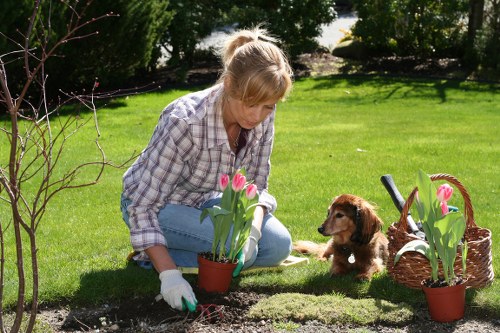Comprehensive Guide to Garden Services in Tree Cutting Service
Introduction to Tree Cutting Services

Maintaining a healthy and aesthetically pleasing garden requires a variety of services, with tree cutting services playing a pivotal role. Whether it's for safety, health, or aesthetic reasons, professional tree cutting ensures that your garden remains vibrant and free from potential hazards.
Tree cutting isn't just about trimming branches; it involves careful planning and execution to promote the longevity and health of your trees. Proper tree cutting can prevent diseases, enhance growth, and improve the overall appearance of your landscape.
In this article, we'll explore the various aspects of tree cutting services, their benefits, and how they integrate into comprehensive garden maintenance plans.
Why Professional Tree Cutting is Essential

Professional tree cutting services are crucial for several reasons, ranging from safety to enhancing the beauty of your garden. Here are some key reasons why hiring experts is beneficial:
- Safety: Overgrown or weakened branches can pose significant risks during storms or high winds.
- Health: Removing dead or diseased branches helps prevent the spread of infections to other parts of the tree.
- Appearance: Well-maintained trees contribute to the overall aesthetic of your garden, making it more inviting.
- Property Value: A landscaped garden with healthy trees can significantly increase the value of your property.
By addressing these aspects, professional tree cutting services ensure that your garden remains a safe, healthy, and beautiful space.
Types of Tree Cutting Services

Tree cutting encompasses a range of services tailored to meet specific needs. Understanding these different services can help you choose the right one for your garden:
Pruning
Pruning involves selectively removing branches to improve tree structure, promote healthy growth, and enhance appearance.
Selective Cutting
This service targets specific trees or branches that are unhealthy or pose risks, without affecting the surrounding vegetation.
Clearance Cutting
Clearance cutting removes all trees from an area, often for construction or to eliminate fire hazards.
Emergency Tree Cutting
In cases of storms or unexpected tree failures, emergency services provide rapid response to mitigate damage.
Tree Removal
When a tree is beyond saving, complete removal is necessary to maintain the safety and aesthetics of your garden.
Each type of tree cutting service serves a unique purpose, ensuring that your garden remains healthy and attractive.
The Tree Cutting Process

Understanding the tree cutting process can help you appreciate the expertise involved in maintaining your garden. Here's a step-by-step overview:
- Assessment: A professional arborist inspects the tree to determine its health and the appropriate cutting method.
- Planning: Developing a strategy that minimizes impact on the surrounding environment and structures.
- Execution: Cutting the tree using specialized equipment and techniques to ensure precision and safety.
- Cleanup: Removing all debris and ensuring the area is left clean and neat.
- Post-Cutting Care: Providing aftercare instructions to ensure the remaining trees continue to thrive.
This meticulous process ensures that tree cutting is performed safely, efficiently, and with minimal disruption to your garden.
Benefits of Regular Tree Cutting

Regular tree cutting offers numerous benefits that contribute to both the health of your trees and the beauty of your garden:
- Enhanced Growth: Proper pruning stimulates new growth and strengthens the tree structure.
- Disease Prevention: Removing infected branches prevents the spread of diseases to other parts of the tree.
- Improved Safety: Eliminating weak or dead branches reduces the risk of them falling and causing injury or damage.
- Aesthetic Appeal: Well-maintained trees enhance the visual appeal of your garden, making it more enjoyable.
- Increased Property Value: A landscaped garden with healthy trees can boost your property's market value.
These benefits highlight why regular tree cutting should be an integral part of your garden maintenance routine.
Choosing the Right Tree Cutting Service
Selecting a reliable and professional tree cutting service is crucial for achieving the best results. Here are some factors to consider:
Experience and Expertise
Ensure the service provider has extensive experience and the necessary expertise to handle various tree cutting scenarios.
Licensing and Insurance
Verify that the company is properly licensed and insured to protect yourself from potential liabilities.
Reputation and Reviews
Check customer reviews and testimonials to gauge the quality of their services and customer satisfaction.
Equipment and Safety Measures
A professional service should use the latest equipment and adhere to strict safety protocols.
Pricing and Estimates
Obtain detailed estimates and compare pricing to ensure you're getting value for your money without compromising on quality.
By considering these factors, you can choose a tree cutting service that aligns with your needs and expectations.
Environmental Considerations
Tree cutting should be performed with environmental sustainability in mind. Here are some practices that contribute to eco-friendly tree maintenance:
- Selective Pruning: Removing only the necessary branches to maintain tree health without excessive cutting.
- Recycling Wood: Utilizing the cut wood for mulch, compost, or wood chips to reduce waste.
- Protecting Nearby Flora: Ensuring that surrounding plants and trees are not adversely affected by the tree cutting process.
- Preventing Soil Erosion: Taking measures to protect the soil structure during and after cutting.
- Using Sustainable Practices: Employing techniques that promote the long-term health and sustainability of the garden ecosystem.
Implementing these practices ensures that tree cutting contributes positively to the environment and the overall health of your garden.
Cost Factors in Tree Cutting Services
The cost of tree cutting services can vary based on several factors. Understanding these can help you budget appropriately:
Tree Size and Height
Larger and taller trees require more labor and equipment, increasing the overall cost of the service.
Accessibility
Trees that are difficult to reach or located in challenging terrains may require additional resources, impacting the price.
Health of the Tree
Trees that are diseased or structurally compromised may require more extensive cutting, thereby increasing costs.
Additional Services
Services such as stump removal, debris disposal, and site cleanup can add to the overall expense.
Location
The geographic location can influence pricing due to varying labor costs and local demand for services.
By understanding these factors, you can better anticipate the costs associated with tree cutting and plan accordingly.
Post-Cutting Tree Care
Aftertree cutting, proper care is essential to ensure the health and longevity of the remaining trees. Here are some recommendations:
- Follow-Up Pruning: Regularly prune the trees to maintain their shape and health.
- Fertilization: Applying the right nutrients can promote growth and prevent diseases.
- Watering: Ensure the trees receive adequate water, especially during dry seasons.
- Pest Control: Monitor for pests and address any issues promptly to prevent infestations.
- Soil Health: Maintain soil quality through mulching and avoiding compaction.
Implementing these care practices helps in sustaining the health and beauty of your trees long after the cutting process.
Innovations in Tree Cutting Technology
The tree cutting industry has seen significant advancements in technology, enhancing efficiency and safety. Some notable innovations include:
Chainsaws and Equipment
Modern chainsaws are more powerful and safer, reducing the risk of accidents and increasing cutting precision.
Aerial Lifts and Cranes
For tall or hard-to-reach trees, aerial lifts and cranes enable workers to perform tree cutting safely and efficiently.
Remote Operated Machinery
Remote-operated machinery minimizes human exposure to hazards, enhancing safety during the cutting process.
Eco-Friendly Practices
Advancements in eco-friendly techniques ensure that tree cutting is performed sustainably, minimizing environmental impact.
Digital Planning Tools
Utilizing digital tools for planning and executing tree cutting projects improves accuracy and project management.
These technological innovations have revolutionized tree cutting services, making them safer, more efficient, and environmentally responsible.
Legal Regulations and Permits
Tree cutting often involves adhering to local laws and obtaining necessary permits. Here's what you need to know:
- Permits: Many areas require permits for cutting down certain trees, especially those considered protected or of significant size.
- Regulations: There are specific regulations regarding the methods and timing of tree cutting to ensure environmental protection.
- Zoning Laws: Zoning laws may dictate where trees can be located and how they can be managed on your property.
- Protected Species: Some trees are protected by law due to their species or ecological importance, and cutting them may require special permissions.
- Penalties: Non-compliance with tree cutting regulations can result in fines or legal action.
It's essential to consult with local authorities and your tree cutting service provider to ensure all legal requirements are met before proceeding with any tree cutting activities.
Choosing the Right Time for Tree Cutting
Timing plays a crucial role in the effectiveness of tree cutting. Here are some considerations for selecting the best time:
- Season: The dormant season, typically late fall or winter, is ideal for most tree cutting as it reduces stress on the tree and minimizes sap loss.
- Weather Conditions: Avoid cutting during adverse weather conditions to ensure safety and optimal cutting conditions.
- Tree Health: Assessing the health of the tree can determine the best time for pruning or removal.
- Growth Cycles: Understanding the growth patterns of your trees can help in scheduling cuts that promote healthy development.
- Project Deadlines: Aligning tree cutting schedules with other garden maintenance activities ensures a cohesive approach to garden care.
Choosing the right time for tree cutting enhances the effectiveness of the service and contributes to the overall health and beauty of your garden.
Common Tree Cutting Mistakes to Avoid
Avoiding common mistakes in tree cutting can prevent damage to your trees and ensure successful outcomes. Here are some pitfalls to watch out for:
- Over-Pruning: Removing too much foliage can stress the tree and impede its growth.
- Improper Tools: Using the wrong tools can cause damage to the tree and increase the risk of accidents.
- Incorrect Cutting Techniques: Poor cutting methods can lead to decay, disease, or structural weakness.
- Failing to Plan: Without a clear plan, tree cutting can become chaotic and less effective.
- Ignoring Safety: Neglecting safety measures can result in accidents and injuries.
By being aware of these common mistakes, you can ensure that tree cutting is performed correctly and safely.
Integrating Tree Cutting with Other Garden Services
Tree cutting is often part of a broader range of garden services. Integrating these services can lead to a more harmonious and well-maintained garden:
Lawn Maintenance
Regular lawn mowing complements tree cutting by maintaining a tidy and healthy ground cover.
Landscape Design
Professional landscape design can enhance the placement of trees and other plants, ensuring a balanced and attractive garden layout.
Irrigation Services
Proper irrigation supports the health of your trees and other plants, making tree cutting even more effective.
Garden Lighting
Strategic garden lighting highlights your trees and enhances the overall ambiance of your outdoor space.
Pest Control
Integrated pest management ensures that your trees remain healthy and free from infestations.
Combining tree cutting with other garden services creates a cohesive maintenance plan that promotes the health and beauty of your entire garden.
Sustainable Practices in Tree Cutting
Adopting sustainable practices in tree cutting not only benefits your garden but also the environment. Here are some ways to ensure sustainability:
- Selective Harvesting: Only removing necessary branches or trees to maintain ecosystem balance.
- Recycling Materials: Using cut wood for beneficial purposes like composting or mulching.
- Minimal Impact Methods: Employing techniques that reduce soil disturbance and protect surrounding vegetation.
- Energy-Efficient Equipment: Using tools and machinery that consume less energy and produce fewer emissions.
- Replanting: Planting new trees to compensate for those that are cut, maintaining the overall tree population.
Implementing these sustainable practices ensures that your garden remains healthy and environmentally friendly.
Tree Cutting and Garden Aesthetics
Tree cutting significantly impacts the visual appeal of your garden. Here's how:
Shape and Structure
Proper cutting enhances the natural shape and structure of trees, making them more visually appealing.
Light and Shade
Strategic pruning can control the amount of light and shade in your garden, creating a balanced environment.
Focal Points
Well-maintained trees can serve as focal points, drawing attention and adding depth to your garden design.
Color and Texture
Different tree species offer a variety of colors and textures, and tree cutting can highlight these features effectively.
Seasonal Changes
Pruning at the right time ensures that trees showcase their best colors and forms during different seasons.
By focusing on these aesthetic aspects, tree cutting enhances the overall beauty and harmony of your garden.
Hiring Certified Arborists
Certified arborists bring specialized knowledge and expertise to tree cutting services. Here's why hiring them is advantageous:
- Professional Training: Certified arborists undergo rigorous training in tree biology, health, and maintenance practices.
- Expertise: They have the skills to assess tree health accurately and determine the best cutting strategies.
- Safety: Arborists are trained in safety protocols, reducing the risk of accidents during tree cutting.
- Knowledge of Regulations: Certified professionals are well-versed in local tree cutting laws and regulations.
- Quality Assurance: Hiring certified arborists ensures high-quality services that maintain tree health and garden aesthetics.
Engaging certified arborists for your tree cutting needs guarantees professional and reliable services.
DIY vs. Professional Tree Cutting
While some homeowners may consider DIY tree cutting, there are significant advantages to hiring professionals:
Safety
Tree cutting involves heights and heavy equipment, posing safety risks that professionals are trained to manage.
Precision
Professional arborists have the expertise to perform precise cuts that promote tree health and aesthetics.
Time and Efficiency
Experts can complete the task more quickly and efficiently, minimizing disruption to your garden.
Proper Equipment
Professionals use specialized tools that ensure effective and clean cuts, which are often not available to homeowners.
Legal Compliance
Hiring professionals ensures that all legal requirements and permits are properly managed.
Cost-Effectiveness
While DIY may seem cheaper initially, mistakes can lead to higher costs in the long run due to potential damage or the need for professional intervention.
Ultimately, professional tree cutting offers safety, expertise, and efficiency that DIY efforts typically cannot match.
Conclusion
Investing in professional tree cutting services is essential for maintaining the health, safety, and beauty of your garden. From enhancing tree growth and preventing diseases to improving garden aesthetics and increasing property value, the benefits are manifold. By understanding the various aspects of tree cutting, including the types of services, the process involved, and the importance of hiring certified arborists, you can make informed decisions that contribute to a thriving and vibrant garden.
Don’t wait until a minor issue becomes a major problem. Contact us today to book your tree cutting service and ensure your garden remains a beautiful and safe haven for years to come.

